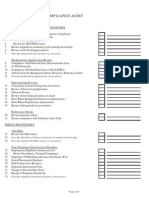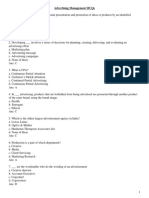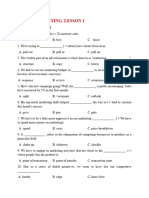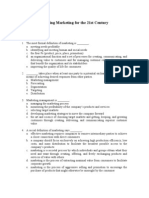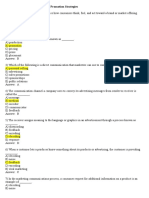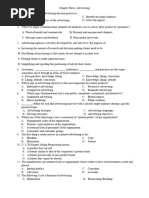Bba304 B1598 MQP
Bba304 B1598 MQP
Uploaded by
Aditya PrakashCopyright:
Available Formats
Bba304 B1598 MQP
Bba304 B1598 MQP
Uploaded by
Aditya PrakashOriginal Description:
Original Title
Copyright
Available Formats
Share this document
Did you find this document useful?
Is this content inappropriate?
Copyright:
Available Formats
Bba304 B1598 MQP
Bba304 B1598 MQP
Uploaded by
Aditya PrakashCopyright:
Available Formats
SIKKIM MANIPAL UNIVERSITY - DDE
Bachelor of Business Administration BBA Semester 3 BBA 304 Advertising and Sales 4 Credits (Book Id B1598)
Model Question Paper Duration: 2 hours Total marks: 140
___________________________________________________________________________
Part A - 1 Mark questions (Questions 1 to 50) 50 * 1 mark = 50 marks
1. Members of __________ group include artists, writers, photographers, directors, producers, printers, as well as self employed freelancers and consultants. a. Advertisers b. Vendors c. Advertising agency d. Media
2. Offering some good reasons to the customers to stick on to a particular brand is for ____________. a. Provoking the user b. Expanding the product distribution c. Encouraging the brand preferences d. Reducing the sales cost 3. ___________ initiates the advertising effort by identifying a marketing problem that advertising may solve. a. Advertising agency b. Media c. Consumer d. Advertiser 4. A particular group of consumers thought to be potential customers for the goods and services constitute the ___________.
a. Audience b. Advertiser c. Target market d. Users
5. ___________ is the deliberate attempt to manage the public's perception of a subject. a. Sales promotion b. Personal selling c. Direct marketing d. Publicity 6. Analysis of promotional programme situation includes ___________. a. Competitor analysis b. External and internal analysis c. Personal selling d. Taking measures to control and adjust promotional strategies 7. The purpose of __________ strategy is to work toward the common goal of customer focused marketing. a. Media b. Advertisement c. Integrated marketing communication d. Sales 8. ____________ is an influential asset for customer behaviour analysis as it has a keen interest in the re-discovery of the true meaning of marketing through the re-affirmation of the importance of the customer or buyer. a. Direct marketing b. Internet marketing c. Personal selling d. Relationship marketing
9. _________ is the study of when, why, how and where people do or do not buy a product or service. a. Integrated Marketing Communication b. Problem recognition c. Consumer behaviour d. Sales promotion
10. Which type of the advertisement message strategy is used by the brand which is the leader and dominant in the industry? a. Pre-emptive b. Generic c. Hyperbole d. Unique selling proposition 11. In which among the following types of advertisement, customer tells about the positive experience with the product? a. Testimonials b. Dramatisation c. Demonstration d. Informative 12. Which among the principles of advertising effectiveness will create an impact on the consumers by repeatedly seeing a specific image? a. Maintaining consistent positioning b. Repeated taglines c. Identifiable selling point d. Maintaining visual consistency 13. ________ appeal aims to focus on the individuals functional or practical needs for particular products and services. a. Emotional b. Rational c. Social d. Political
14. A person who shapes and sculpts the words in an advertisement is called ________. a. Graphic designer b. Copywriter c. Art director d. Advertiser
15. The headline must work in combination with the _________ to stop and grab the readers attention . a. Sound effects b. Music c. Visual d. Body copy 16. Name the characteristics of TV advertisement where the narration of the advertisement is used to describe the content. a. Demonstration b. Story telling c. Inattention d. Emotion 17. __________ includes all elements that readers see in their initial scanning. a. Display copy b. Body copy c. Layout d. Copy sheet 18. __________ is a key element in print advertising. a. Tagline b. Caption c. Headline d. Body copy
19. _________ = [Cost of ad space (absolute cost) / Circulation] x1000 a. Cost Per Thousand b. Daily inch rate c. Cost of commercial time d. Cost per Rating points 20. The goal of the________ is to find the best combination of media that enables the marketer to communicate the message in the most effective manner to the largest number of potential customers at the lowest cost. a. Market analysis b. Media plan c. Media objectives d. Media strategy 21. Which of the following internal factor influences the media strategy? a. Size of the media budget b. Economy c. Changes in technology d. Competitive factors 22. Which of the following form of advertisement is more influential as it is less suspicious compared to advertising? a. Print b. Broadcast c. Planned d. Unplanned 23. Which among the following can be classified as speciality advertising? a. Advertisement in television b. Advertisement in pencils c. Advertisement in newspaper
d. Advertisement in radio
24. _________ advertisements are arranged by subject matter for the convenience of readers and generally do not include headlines or illustrations. a. Retail b. National c. Classifieds d. Reading notices
25. __________ advertisements are situational. a. Print b. Directory c. Radio d. Out-of-home 26. Which among the following is also known as cooperative advertisement? a. Classifieds b. Retail c. National d. Reading notices 27. Which among the following institute researched and revealed that people who viewed advertisements in magazine were 2 percent to 37 percent more likely to purchase the product than the people who viewed the advertisements on TV. a. A.C. Neilson Company b. Stanford Research Institute c. Master of Marketing Research d. Research Methods Institute 28. Which among the following is the oldest established form of advertising?
a. Directory advertising b. Newspaper c. Brand name advertising d. Outdoor advertising 29. ___________ reaches prospects or people who already know they have a need for the product and service a. Brand image advertising b. Directory advertising c. Outdoor advertising d. Retail advertising
30. Which among the following spots are referred as overnight in radio advertising? a. 7pm- 11pm b. 11pm- midnight c. Midnight- 6am d. Midnight- 5am
31. Who among the following are the heaviest users of radio? a. National advertisers b. International advertisers c. Individual advertisers d. Local advertisers 32. __________ allow nonprofit groups and the government a limited number of free spots to promote messages and information for the general safety of the public. a. Advertisers b. Organisations c. Broadcasters d. Copywriters
33. The purchase of _________ provides greater flexibility in selecting markets, individual stations and airtime and adjusting the message for local market conditions. a. Local radio b. National radio c. Spot radio d. Cable radio 34. ___________ is also called as online advertising. a. Television advertising b. Radio advertising c. Internet advertising d. Email advertising 35. Email marketing is a form of ________ which uses electronic mail as a means of communicating commercial or fund-raising messages to audience a. Direct marketing b. Indirect marketing c. Social media marketing d. Channel marketing
36. ___________ is the deliberate attempt to manage the public's perception of a subject. a. Media monitoring b. Publicity c. Public relation d. Marketing 37. If the company does not have the financial capabilities to engage in promotional expenditures, the best way to communicate to these groups is through __________. a. Publicity b. Marketing
c. Advertisements d. Public relations 38. The area which occupies considerable amounts of time for any public relations department is the relationship with the ______. a. Non-profit body b. Media c. Financial group d. Suppliers
39. A _________ consists of a plan that positions a company's brand or product to gain a competitive advantage. a. Media strategy b. Sales strategy c. Operational strategy d. Strategic evaluation 40. Sales Cost of Sales = _______ a. Net profit b. Monopoly profit c. Gross Profit d. Super profit
41. In which among the following era, the audience were able to control when and where the media can reach them? a. Premarketing era b. Mass communication era c. Interactive era d. Research era
42. Which among the following is the first objective of advertisement? a. Desire
b. Attention c. Satisfaction d. Interest
43. Which type of advertisement communicates a message on behalf of some good cause, such as AIDS awareness, preventing child abuse or right to education? a. Nonprofit advertisement b. Public service advertisement c. Institutional advertisement d. Brand advertisement
44. Who among the following assist the advertisers, advertising agencies and the media in creating and placing the advertisements? a. Advertisers b. Vendors c. Advertising agency d. Media
45. Which among the following type of advertisement focuses on establishing a corporate identity or winning the public over to the organisations point of view? a. Business to business advertising b. Local advertising c. Institutional advertising d. Public service advertising
46. In which among the following roles, advertising is seen as a vehicle for helping consumers assess value, through price as well as other information such as quality, location and reputation? a. Marketing b. Societal c. Economical
d. Communication
47. Which among the following message strategies aim to design an advertisement that impacts a persons beliefs or knowledge structure? a. Affective b. Cognitive c. Conative d. Generic
48. Which among the stages of hierarchy-of-effects involves fixing the problems of the product, if it has any? a. Preference b. Liking c. Conviction d. Awareness
49. __________ provides support and details about the product or the current offer. a. Headline b. Subhead line c. Tagline d. Body copy
50. Which among the following elements in the advertisement creation deals with the link between the benefit and personal value of the product? a. Product attributes b. Personal values c. Leverage point d. Consumer benefits
Part B - 2 Mark Questions (Questions 51 to 75)
25 * 2 mark = 50 marks
51. Which among the following is the consumer oriented sales promotion? 1. Price deal 2. Off-invoice discounts 3. Performance incentives 4. Loyal reward program a. Options 1 & 3 b. Options 2 & 4 c. Options 1 & 4 d. Options 2 & 3 52. Consider the below mentioned statements: 1. Primary appeal of advertisements are emotional. 2. Contribution of advertisements to profit is high. State True or False: a. 1-True, 2-True b. 1-False, 2-True c. 1-False, 2-False d. 1-True, 2-False 53. Which among the following is the price based trade promotion? 1. Off-invoice discounts 2. Performance incentives 3. Slotting allowance 4. Promotional allowance a. Options 1 & 2 b. Options 2 & 3 c. Options 1 & 3 c. Options 1 & 4 54. Sales promotion can be broken down into two major categories called ________ and ________.
a. Market oriented, consumer oriented b. Consumer oriented, trade oriented c. Cost oriented, trade oriented d. Market oriented, cost oriented 55. Which among the following are the steps involved in the personal selling process? 1. Approach 2. Prospecting 3. Building product awareness 4. Providing information a. Options 1 & 3 b. Options 2 & 4 c. Options 1 & 2 d. Options 2 & 3 56. Consider the below mentioned statements: 1. Action is a motivation to act and leads towards the next stage. 2. Providing technical advice and assistance to customers is the qualitative objective of personal selling. State True or False: a. 1-True, 2-True b. 1-False, 2-True c. 1-True, 2-False d. 1-False, 2-False 57. Which among the following are the benefits of personal selling from the consumer's point of view? 1. Inform about new products 2. Creates new customers 3. Leads product improvement 4. Give opportunity to put forward the complaints a. Options 1 & 2
b. Options 2 & 3 c. Options 3 & 4 d. Options 1 & 4 58. Consider the below mentioned statements: 1. The pre-approach is the actual contact the sales person has with the prospect. 2. Diligent follow-up lead to uncovering new needs, additional purchases and also referrals and testimonials which can be used as sales tools. State True or False: a. 1-True, 2-True b. 1-False, 2-True c. 1-False, 2-False d. 1-True, 2-False 59. Consider the below mentioned statements: 1. When a company operation is relatively small, it intends to establish sales territory. 2. Sales force is one of the most expensive human resource investments. State True or False: a. 1-True, 2-True b. 1-False, 2-True c. 1-False, 2-False d. 1-True, 2-False 60. Which among the following are the reasons for sales territory? 1. To provide better coverage. 2. To provide quantitative performance standard. 3. To improve customer service. 4. To work out sound compensation plan. a. Options 2 & 4 b. Options 1 & 2
c. Options 3 & 4 d. Options 1 & 3 61. Consider the below mentioned statements: 1. Budget quotas are required to make the sales force perform some other activities which have long term implications on goodwill of the firm. 2. Upselling is a key to success for many businesses. State True or False: a. 1-True, 2-True b. 1-False, 2-True c. 1-False, 2-False d. 1-True, 2-False 62. _______ and __________ of sales territories facilitates matching the selling effort with sales opportunity. a. Design, establishment b. Resources, establishment c. Ideas, information d. Resources, ideas 63. Which among the following type of sales organisation structure is the most commonly used? 1. Line sales organisation 2. Line and staff sales organisation 3. Functional sales organisation 4. Committee sales organisation a. Options 1 & 3 b. Options 2 & 4 c. Options 1 & 2 d. Options 2 & 3 64. Consider the below mentioned statements: 1. Straight salary provides salespeople a secure income 2. Straight salary is related to unit of work.
State True or False: a. 1-True, 2-True b. 1-False, 2-True c. 1-False, 2-False d. 1-True, 2-False 65. Which among the following are the part of evaluation of sales training? 1. Reactions of participants 2. Gaming 3. Change in behaviour 4. Testing a. Options 1 & 2 b. Options 1 & 3 c. Options 3 & 4 d. Options 2 & 4 66. Consider the below mentioned statements: 1. Straight salary provides no financial incentive to salespeople to exert more effort and to improve performance 2. Commission payout is the time when the commissions are paid. State True or False: a. 1-True, 2-True b. 1-False, 2-True c. 1-False, 2-False d. 1-True, 2-False
67. Consider the below mentioned statements: 1. Sales audit involves an analysis of a companys sales in terms of such factors as product, revenue and area. 2. The independent audit divulges new opportunities for growth, training, channel expansion and process improvements. State True or False:
a. 1-True, 2-True b. 1-False, 2-True c. 1-False, 2-False d. 1-True, 2-False 68. Which among the following are aims of sales audit in a sales organisation? 1. To know about the current interest of customers 2. To find out the true and accurate position of sales 3. To find out the strength of the competitor 4. To bring alertness to the organisation a. Options 1 & 4 b. Options 1 & 2 c. Options 1 & 3 d. Options 2 & 4 69. Consider the below mentioned statements: 1. White lies do not affect the trust of the customer. 2. One of the most important responsibilities of sales managers is to evaluate the performance of their sales people. State True or False: a. 1-True, 2-True b. 1-False, 2-True c. 1-False, 2-False d. 1-True, 2-False 70. Which among the following is the purpose of performance evaluation and control of sales people? 1. Improve the sales persons performance by identifying the causes of unsatisfactory performance 2. Improve decisive events into behavioural anchor statements 3. Rate the effectiveness of the behavioural statements 4. Find out their strengths and weaknesses
a. Options 2 & 4 b. Options 1 & 2 c. Options 3 & 4 d. Options 1 & 4
71. Consider the below mentioned statements: 1. Testimonial type of advertisements employ a physician, dentist, engineer or chemist to state the particular brands features and advantages compared to other brands. 2. Dramatisation is similar to the slice-of-life executional framework State True or False: a. 1-False, 2-False b. 1-True, 2-False c. 1-True, 2-True d. 1-False, 2-True
72. Which among the following are the stages in the hierarchy-of-effects model? 1. Awareness 2. Consumer benefits 3. Leverage point 4. Knowledge
a. Options 1 & 4 b. Options 1 & 2 c. Options 1 & 3 d. Options 2 & 3
73. Consider the below mentioned statements: 1. Resonance advertising attempts to connect a product with a consumers experiences to develop stronger ties between the product and the consumer. 2. Generic messages compare the product's attribute with the competition. State True or False: a. 1-True, 2-True b. 1-False, 2-True
c. 1-False, 2-False d. 1-True, 2-False
74. Which among the following are the functions of the headline? 1. Provide smooth transition to the body line 2. Attracts the target market 3. Arouses emotions 4. Contains brand symbol
a. Options 1 & 4 b. Options 1 & 2 c. Options 1 & 3 d. Options 2 & 3
75. Which among the following are the characteristic of radio advertising? 1. Retention 2. Demonstration 3. Call to action 4. Action
a. Options 3 & 4 b. Options 1 & 2 c. Options 1 & 3 d. Option 2 & 3
Part C Answer all the questions 4*10 = 40 marks
76. Define advertisement and explain its major characteristics with examples. What are the various functions of advertising? (Refer to unit 1)
77. What do you understand by the term Integrated Marketing Communication (IMC)? What are the various roles of IMC? (Refer to unit 2)
78. Explain the role of sales force. What are the steps involved in training the sales force? (Refer to unit 13)
79. List the types of analysis for evaluating sales organization. Explain cost analysis and profitability analysis. (Refer to unit 14)
You might also like
- HR Compliance ChecklistDocument5 pagesHR Compliance ChecklistPragat Naik100% (2)
- Kotler Chapter 14 MCQDocument44 pagesKotler Chapter 14 MCQAnthony Scott100% (12)
- SAP SD Configuration GuideDocument363 pagesSAP SD Configuration Guiderajendrakumarsahu94% (54)
- Chapter 15 - Advertising and Public RelationsDocument19 pagesChapter 15 - Advertising and Public RelationsNgọc DiệpNo ratings yet
- Customs PoaDocument5 pagesCustoms PoaAtlas SNo ratings yet
- Marketing Management MCQDocument44 pagesMarketing Management MCQeffendy100% (1)
- Brand and Product Management ExamsDocument11 pagesBrand and Product Management Examskondwani B J Manda100% (2)
- CH 4. PromotionDocument21 pagesCH 4. Promotionmuhammed zidanNo ratings yet
- Advertising Management ObjectivesDocument10 pagesAdvertising Management ObjectivesSantosh KarthikNo ratings yet
- Advertising and Sales ManagementDocument13 pagesAdvertising and Sales ManagementRameez Bhat0% (1)
- Am MCQ-1Document9 pagesAm MCQ-1Kunal JaiswalNo ratings yet
- MM8 MidtermDocument40 pagesMM8 Midtermlaarni joy conaderaNo ratings yet
- Advertising Management MCQDocument7 pagesAdvertising Management MCQAjudiya Meet86% (7)
- Chapter 14 Communicating Customer Value: Integrated Marketing Communications StrategyDocument6 pagesChapter 14 Communicating Customer Value: Integrated Marketing Communications StrategyHíu Trừn Thu HaiNo ratings yet
- Bba - Sem Vi Advertising and Salesman ShipDocument15 pagesBba - Sem Vi Advertising and Salesman Shipdeepshah8486No ratings yet
- Chapter 14Document19 pagesChapter 14Hải Hà Bạch ThịNo ratings yet
- Marketing ManagementDocument31 pagesMarketing ManagementNgọc QuýNo ratings yet
- Chapter 14Document6 pagesChapter 14Abdullah Jutt100% (1)
- Marketing ExamDocument5 pagesMarketing ExamDennisBrionesNo ratings yet
- 203 Marketing Management Mcq. 1 60 1Document12 pages203 Marketing Management Mcq. 1 60 1rungtacherry21No ratings yet
- Advt MCQ For Form 3Document3 pagesAdvt MCQ For Form 3Aejaz MohamedNo ratings yet
- Quiz # 1 FOM 2022Document4 pagesQuiz # 1 FOM 2022Muqaddas ImranNo ratings yet
- Chapter 14 Engaging Consumers and Communicating Customer Value: Integrated Marketing Communications StrategyDocument21 pagesChapter 14 Engaging Consumers and Communicating Customer Value: Integrated Marketing Communications StrategyRosyLeeNo ratings yet
- Media Planning ObjectivesDocument13 pagesMedia Planning ObjectivesSudhanshu JaiswalNo ratings yet
- Marketing Management MCQDocument42 pagesMarketing Management MCQAbdul Rehman Chahal75% (4)
- MarketingDocument5 pagesMarketingRosellaNo ratings yet
- Unit 3 - Marketing - Lesson 1Document6 pagesUnit 3 - Marketing - Lesson 1halam29051997No ratings yet
- Chapter 3 - Marketing - Lesson 1Document6 pagesChapter 3 - Marketing - Lesson 1k63.2414215014No ratings yet
- Advertising Questions and AnswersDocument3 pagesAdvertising Questions and AnswersMalik Mohamed100% (2)
- Advertising Management BBA301Document22 pagesAdvertising Management BBA301manishNo ratings yet
- 1stperiodicalexam PrinMrktg UploadDocument5 pages1stperiodicalexam PrinMrktg Uploadjay reamonNo ratings yet
- Đề Thi MarketingDocument7 pagesĐề Thi MarketingNguyen Tran Thi ThaoNo ratings yet
- Chapter 15Document19 pagesChapter 15Hải Hà Bạch ThịNo ratings yet
- Advertising and Brand ManagementDocument11 pagesAdvertising and Brand ManagementAditya BhargavaNo ratings yet
- 611B - ImcDocument20 pages611B - ImcRushi100% (1)
- (12 Copies) MM 6 - Midterm Exam - Summer - AY2022-2023Document3 pages(12 Copies) MM 6 - Midterm Exam - Summer - AY2022-2023Jasmin SansawiNo ratings yet
- BNN College (A, S & C), Bhiwandi Marketing (Commerce V) : Padmashri Annasaheb Jadhav Bhartiya Samaj Unnati Mandal'sDocument47 pagesBNN College (A, S & C), Bhiwandi Marketing (Commerce V) : Padmashri Annasaheb Jadhav Bhartiya Samaj Unnati Mandal'sguptaman6688No ratings yet
- KO ĐÁP ÁN - 100 Questions (English For Marketing)Document21 pagesKO ĐÁP ÁN - 100 Questions (English For Marketing)Tuyền NguyễnNo ratings yet
- Multiple ChoiceDocument55 pagesMultiple ChoiceEvelyn RitsakiNo ratings yet
- 364w4 - Advertising and Marketing ResearchDocument32 pages364w4 - Advertising and Marketing Researchsonu100% (1)
- Midterm Model AnswersDocument7 pagesMidterm Model AnswersVignish SwaminathanNo ratings yet
- MarDocument55 pagesMarquyenb2206588No ratings yet
- IMC Quiz Chapter 1 and 2Document3 pagesIMC Quiz Chapter 1 and 2hassoviyan9No ratings yet
- Defining Marketing For The 21st CenturyDocument14 pagesDefining Marketing For The 21st CenturyAnoushaNo ratings yet
- Chapter 16 Advertising and Sales Promotion StrategiesDocument12 pagesChapter 16 Advertising and Sales Promotion StrategiesMeconNo ratings yet
- Tut 11 - QDocument4 pagesTut 11 - QKWANG QING XUANNo ratings yet
- Kotler Chapter 15 MCQDocument42 pagesKotler Chapter 15 MCQAnthony Scott87% (55)
- Imc TestDocument16 pagesImc TestChen SingNo ratings yet
- IMC 3 and 4 ExamDocument8 pagesIMC 3 and 4 Examhassoviyan9No ratings yet
- Chapter 1: Defining Marketing For The 21st CenturyDocument69 pagesChapter 1: Defining Marketing For The 21st CenturyMinh TrầnNo ratings yet
- PDF MCQS Question Bank No.5 For TY BBA Subject - Adv. & Sales PromotionDocument17 pagesPDF MCQS Question Bank No.5 For TY BBA Subject - Adv. & Sales PromotionHanisha RathodNo ratings yet
- Exit Exam WorksheetDocument30 pagesExit Exam Worksheetbiniyamsemere090No ratings yet
- Principles of Marketing - First Quarter ExamDocument5 pagesPrinciples of Marketing - First Quarter ExamBilly Jasper Domingo100% (1)
- Trac Ngiem 332Document7 pagesTrac Ngiem 332ngan phanNo ratings yet
- mm8 Additional QuestionsDocument9 pagesmm8 Additional Questionslaarni joy conaderaNo ratings yet
- Advertising-Management-MCQ With Ans Bba2ndDocument43 pagesAdvertising-Management-MCQ With Ans Bba2ndrungtacherry21No ratings yet
- All ExamDocument63 pagesAll ExamLegese TusseNo ratings yet
- Marketing and Sales Strategies: Maximize Your Sales Performance with This Comprehensive Guide to Marketing and Selling StrategiesFrom EverandMarketing and Sales Strategies: Maximize Your Sales Performance with This Comprehensive Guide to Marketing and Selling StrategiesNo ratings yet
- How to Sell (eCommerce) - Marketing and Internet Marketing StrategiesFrom EverandHow to Sell (eCommerce) - Marketing and Internet Marketing StrategiesNo ratings yet
- Advertising Made Easy: How to Create Campaigns That Capture AttentionFrom EverandAdvertising Made Easy: How to Create Campaigns That Capture AttentionNo ratings yet
- Mastering Social Media Marketing: A Comprehensive Guide for Success.From EverandMastering Social Media Marketing: A Comprehensive Guide for Success.No ratings yet
- Social Media Marketing: Strategies for Engaging and Converting Audiences: Marketing 360°: The Power of Modern MarketingFrom EverandSocial Media Marketing: Strategies for Engaging and Converting Audiences: Marketing 360°: The Power of Modern MarketingNo ratings yet
- Self Learning TallyERP 9Document7 pagesSelf Learning TallyERP 9Sanjay ChaukekarNo ratings yet
- Board of High School and Intermediate Education Uttar PradeshDocument1 pageBoard of High School and Intermediate Education Uttar PradeshAditya PrakashNo ratings yet
- Dependent Drop Down ListsDocument2 pagesDependent Drop Down ListsAditya PrakashNo ratings yet
- January 2014: Sunday Monday Tuesday Wednesday Thursday Friday SaturdayDocument12 pagesJanuary 2014: Sunday Monday Tuesday Wednesday Thursday Friday SaturdayAditya PrakashNo ratings yet
- Last Name Sales Country QuarterDocument1 pageLast Name Sales Country QuarterAditya PrakashNo ratings yet
- Budget LimitDocument1 pageBudget LimitAditya PrakashNo ratings yet
- Bachelor of Business Administration Semester 3 Subject Code: BBA302 Subject: Human Resource Management (Book ID: B1596) Model Question PaperDocument19 pagesBachelor of Business Administration Semester 3 Subject Code: BBA302 Subject: Human Resource Management (Book ID: B1596) Model Question PaperAditya PrakashNo ratings yet
- MARCH 2013: This Is Computer Generated, Signature Is Not Require Generated OnDocument1 pageMARCH 2013: This Is Computer Generated, Signature Is Not Require Generated OnAditya PrakashNo ratings yet
- PS 3270 1208Document1 pagePS 3270 1208Aditya PrakashNo ratings yet
- Experience Certificate From The Industry: To Whom-So-Ever It May ConcernDocument1 pageExperience Certificate From The Industry: To Whom-So-Ever It May ConcernAditya PrakashNo ratings yet
- Raj Program MaerDocument1 pageRaj Program MaerAditya PrakashNo ratings yet
- Engineering Management Chapter 3Document16 pagesEngineering Management Chapter 3AdieNo ratings yet
- Implement 0212Document114 pagesImplement 0212gamurphy65No ratings yet
- Resume Valle JennelynDocument2 pagesResume Valle Jennelynk7zzk7xqyjNo ratings yet
- Unisa MNP2602 Chapter 4Document12 pagesUnisa MNP2602 Chapter 4Huỳnh HuỳnhNo ratings yet
- Annual Report 2022Document292 pagesAnnual Report 2022Baby Joisue KallabueliaNo ratings yet
- Payslip 75116420200501Document2 pagesPayslip 75116420200501Rudy IskandarNo ratings yet
- Summer Internship Project - SatyaDocument19 pagesSummer Internship Project - SatyaAnonymous KIcdN7K6K6No ratings yet
- A Practical Guide To InsolvencyDocument172 pagesA Practical Guide To Insolvencyberindersahni100% (1)
- 26 04 2010 ProspectusDocument544 pages26 04 2010 ProspectusPrateek BhasinNo ratings yet
- Adaptability Interview Questions PDFDocument2 pagesAdaptability Interview Questions PDFdavidjovisNo ratings yet
- (BS) Economics B.K Singh: SourcesDocument35 pages(BS) Economics B.K Singh: SourcesAyesha Naaz100% (1)
- Bba Aviaton SyallabusDocument1 pageBba Aviaton Syallabusrakesh varmaNo ratings yet
- Patience Boutique Business PlanDocument18 pagesPatience Boutique Business PlanMAVERICK MONROENo ratings yet
- Institute of Actuaries of India: Subject CT2 - Finance and Financial ReportingDocument6 pagesInstitute of Actuaries of India: Subject CT2 - Finance and Financial ReportingVignesh Srinivasan0% (1)
- OMLF FY 2018 Annual Report - Financial Section PDFDocument81 pagesOMLF FY 2018 Annual Report - Financial Section PDFyouismyfavcolourNo ratings yet
- Financial Statements of A Company As An Information Base For Decision-Making in A Transforming EconomyDocument13 pagesFinancial Statements of A Company As An Information Base For Decision-Making in A Transforming EconomyToheebdareNo ratings yet
- Proposal Portfolio FB MarketingDocument7 pagesProposal Portfolio FB MarketingKishen SreedharanNo ratings yet
- Expansion Strategies: Dr. Sandeep KulshresthaDocument19 pagesExpansion Strategies: Dr. Sandeep KulshresthaNishchup NishachariNo ratings yet
- JPIA Review S2 - Cost Accounting and ControlDocument29 pagesJPIA Review S2 - Cost Accounting and ControlrylNo ratings yet
- Star Material Handling Company LTDDocument9 pagesStar Material Handling Company LTDlokesh1179100% (1)
- Relaxo Footwears LTD Leave Policy Final V3 0Document13 pagesRelaxo Footwears LTD Leave Policy Final V3 0Joseph RajkumarNo ratings yet
- Customer Relationship ManagementDocument90 pagesCustomer Relationship ManagementShree BontalNo ratings yet
- Long Quiz For InvestmentDocument2 pagesLong Quiz For InvestmentBarbie BleuNo ratings yet
- Stevenson - 13e - Chapter - 8 RevisedDocument39 pagesStevenson - 13e - Chapter - 8 RevisedjuniorhaguaiNo ratings yet
- Lalita ChauhanDocument73 pagesLalita ChauhanShubham ChauhanNo ratings yet
- Transshipment ProblemDocument4 pagesTransshipment ProblemGhani RizkyNo ratings yet
- Project Research Report: "Digital Marketing Strategies: A Case of Vodafone Zoo Zoo in Contribution To Vodafone's Growth"Document56 pagesProject Research Report: "Digital Marketing Strategies: A Case of Vodafone Zoo Zoo in Contribution To Vodafone's Growth"Shubham bajajNo ratings yet
- Mock Call ScriptDocument2 pagesMock Call ScriptmayannarnanteNo ratings yet
